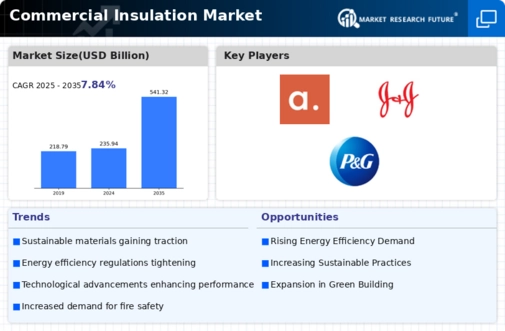Market Trends and Projections
The Global Commercial Insulation Market Industry is characterized by dynamic trends and projections that highlight its growth potential. The market is anticipated to reach 235.94 USD Billion in 2024, with a robust trajectory leading to an estimated 541.32 USD Billion by 2035. This growth is underpinned by a compound annual growth rate (CAGR) of 7.84% from 2025 to 2035. Key factors driving this expansion include increasing energy efficiency demands, regulatory support for sustainable practices, and technological advancements in insulation materials. As the industry evolves, stakeholders are likely to adapt to these trends to capitalize on emerging opportunities.
Growing Demand for Energy Efficiency
The Global Commercial Insulation Market Industry experiences a notable surge in demand for energy-efficient solutions. As energy costs continue to rise, businesses are increasingly investing in insulation materials that enhance energy conservation. This trend is particularly evident in commercial buildings, where insulation plays a crucial role in reducing heating and cooling expenses. The market is projected to reach 235.94 USD Billion in 2024, reflecting a growing awareness of the financial and environmental benefits of effective insulation. Enhanced energy efficiency not only lowers operational costs but also contributes to sustainability goals, making insulation a vital component in modern construction practices.
Increased Awareness of Indoor Air Quality
The Global Commercial Insulation Market Industry is influenced by a growing awareness of indoor air quality (IAQ) among building occupants and owners. Insulation materials play a critical role in maintaining IAQ by minimizing the infiltration of pollutants and allergens. As businesses prioritize the health and well-being of employees, the demand for insulation that contributes to cleaner indoor environments is rising. This trend is reflected in the increasing preference for non-toxic and eco-friendly insulation materials. The focus on IAQ is likely to drive market growth, as organizations recognize the importance of creating healthier workspaces, thereby enhancing productivity and employee satisfaction.
Technological Advancements in Insulation Materials
Innovations in insulation technology are transforming the Global Commercial Insulation Market Industry. The development of advanced materials, such as aerogels and vacuum insulation panels, offers superior thermal performance and space-saving benefits. These innovations not only enhance energy efficiency but also provide architects and builders with versatile options for various applications. The market's growth is further supported by ongoing research and development efforts aimed at improving insulation properties and reducing costs. As these technologies gain traction, they are expected to contribute significantly to the projected CAGR of 7.84% from 2025 to 2035, reflecting a robust demand for cutting-edge insulation solutions.
Rising Construction Activities in Emerging Economies
The Global Commercial Insulation Market Industry is poised for growth due to the increasing construction activities in emerging economies. Rapid urbanization and infrastructure development in regions such as Asia-Pacific and Latin America are driving the demand for commercial insulation. As new commercial buildings are constructed, the need for effective insulation solutions becomes paramount to ensure energy efficiency and compliance with local regulations. This trend is particularly pronounced in countries like India and Brazil, where government initiatives are promoting sustainable construction practices. Consequently, the market is expected to expand significantly, aligning with the overall growth trajectory of the construction sector in these regions.
Regulatory Support for Sustainable Building Practices
Regulatory frameworks worldwide increasingly emphasize sustainability in construction, significantly impacting the Global Commercial Insulation Market Industry. Governments are implementing stringent building codes and standards that mandate the use of high-performance insulation materials. These regulations aim to reduce carbon footprints and promote energy efficiency in commercial buildings. For instance, the adoption of LEED certification and similar programs encourages the use of insulation that meets specific environmental criteria. As a result, the market is likely to see substantial growth, with projections indicating a rise to 541.32 USD Billion by 2035, driven by compliance with these evolving regulations.













